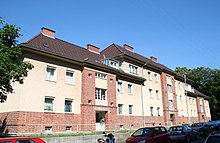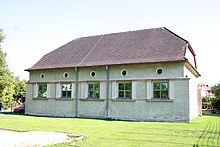Pestalozzistraße (Linz)
| Pestalozzistrasse | |
|---|---|
| Street in Linz | |
| Basic data | |
| place | Linz |
| District | Kleinmünchen |
| use | |
| User groups | Car traffic , foot traffic |
| Technical specifications | |
| Street length | approx. 1300 meters |
The Pestalozzi Street is a street in the Upper Austrian capital Linz . It is located in the cadastral municipality of Kleinmünchen (statistical district Kleinmünchen-Auwiesen ) and was named after the Swiss pedagogue Johann Heinrich Pestalozzi (1746–1827).
history
Pestalozzistraße was called Friedhofstraße (today Urnenhain Kleinmünchen ) because of the cemetery of the formerly independent community of Kleinmünchen . In 1929 the street was renamed Alfons-Petzold-Straße after the social democratic writer Alfons Petzold (1882-1923). After the February fighting in 1934 , the street was renamed Pestalozzistraße by representatives of the corporate state .
Location and characteristics
Pestalozzistraße branches off from Höniggasse in the north in a south-south-east direction and joins Denkstraße in the south . The 1,300-meter-long road originally branched off from the Salzburger Strasse, which is 130 meters further north . To protect the groundwater, however, it was provided with concrete walls on both sides around 1980 and the connection to Pestalozzistraße was cut. Today the area between Salzburger Straße and Höniggasse is forested. The course of Pestalozzistraße in the northern area is strongly characterized by its location in the water forest, with large forest areas and the “senior citizens' park” being located here. Several buildings have been bought and demolished here by the city of Linz in the last few decades. The facilities of two sports clubs and the Pestalozzistraße children's outdoor pool are located along the southern course of the road.
building
Urn Grove Kleinmünchen
The Urnenhaun was opened at the beginning of the 19th century as a cemetery for the community of Kleinmünchen and has a rectangular area of around 9000 m² and a funeral hall. Today's urn grove is operated by Linz AG and from the Linz / St. Martin looked after.
No. 79 ASKÖ Linz-Kleinmünchen
Next to the Kleinmünchen urn grove is the ASKÖ Linz-Kleinmünchen site. The club, founded in 1920 as a “Workers' Gymnastics and Sports Club” in the “Goldenes Schiff” inn, is the oldest sports club in Kleinmünchen. In addition to gymnastics and athletics, the club also dealt with handball and fistball in the interwar period. Initially, the field meadow served as sports facilities and, in winter, the gymnasium of the Kleinmünchner municipal office. The game operations later moved to the worker's home on today's corner of Simonystraße and Franz-Kurz-Straße. After the club was banned between 1934 and 1945, sports operations were resumed in 1946 and in 1949 the expansion of the company's own sports facility on Pestalozzistraße began. Between 1975 and 1977 the construction of today's sports home with a multi-purpose hall, buffet, sauna, changing rooms and groundskeeper apartment began. In 1975, the Kleinmünchen department of the ATSV-Linz club was transformed into the independent association “ASKÖ Linz-Kleinmünchen”. In 2009 the tennis club Lißfeld merged with the ASKÖ Kleinmünchen, in 2013 the club house reopened after renovations. The club's sports offer today includes gymnastics, tennis and stick sports, the inline hockey facility is made available to other clubs or teams for a fee.
No. 84 Kindergarten
Today's kindergarten in Linz was built between 1888 and 1889 by the Upper Austrian Construction Company (HF Scheck) as a hospital for the community of Kleinmünchen with initially 26 beds. The building later served as an infant home, housed an elementary school from 1935 and a daycare center from 1966. After the special school there closed, the after-school care center moved to Pestalozzistraße 96. Due to bomb damage from the Second World War, the building now has a simplified structure. The east facade facing the street has a grooved ground floor, the double windows on the upper floor have a straight roof or triangular gable. On the north side, the entrance area was designed with a portico porch on pilasters, which was subsequently redesigned into a vestibule with glass tiles. The eternit-clad west side has a protruding staircase risalit.
No. 84a, 86, 86a Municipal housing
The building was erected in 1926 by the Linz City Planning Department and planned by the architect Hans Feichtlbauer . The three-story middle section with two two-story side sections houses 28 small apartments, with the attic extension being carried out between 1951 and 1952. The 15-axis facade is characterized by an alternation between clinker cladding and rough plaster surfaces. Exposed concrete lintels of the entrance portals were used as additional accents. There are wooden stairs inside the listed building.
No. 92 ASKÖ Donau Linz
The sports facility, equipped with three soccer fields and tennis courts, houses the ASKÖ Donau Linz association. The football section's combat team plays in the fourth-class Upper Austria league .
No. 94 gym
The gymnasium built by the community of Kleinmünchen between 1923 and 1924 was built by the civil engineering company under master builder Adolf Grohmann. The listed building has a T-shaped floor plan and a two-story entrance and cloakroom wing. The transverse hall building with a half-hip roof has a five-axis structure on the north facade facing the street with square pilasters on the windows and octagonal openings below the roof.
No. 96 day care center
Today's daycare center was probably built as a school building in the second half of the 19th century and added to by the community of Kleinmünchen in 1921. Conversions took place in 1935 and 1963 (facade simplification). The building with a four-axis central projectile and gable housed the special school in Kleinmünchen for a long time.
literature
- Herfried Thaler, Bernhard Prokisch and others: Austrian Art Topography, Volume LV “The profane architectural and art monuments of the city of Linz”, III. Part: Outside areas, Urfahr, Ebelsberg. Berger & Söhne, Ferdinand, 2001, published by the Federal Monuments Office, Department for Inventory and Monument Research, ISBN 978-3-85028-343-4 , S: 316 ff.
Web links
Individual evidence
- ↑ linz.at city's history - Linzer street names
- ^ ASKÖ Linz-Kleinmünchen Chronicle of the oldest sports club in Kleinmünchen
Coordinates: 48 ° 15 ′ 28.8 " N , 14 ° 18 ′ 35.9" E


